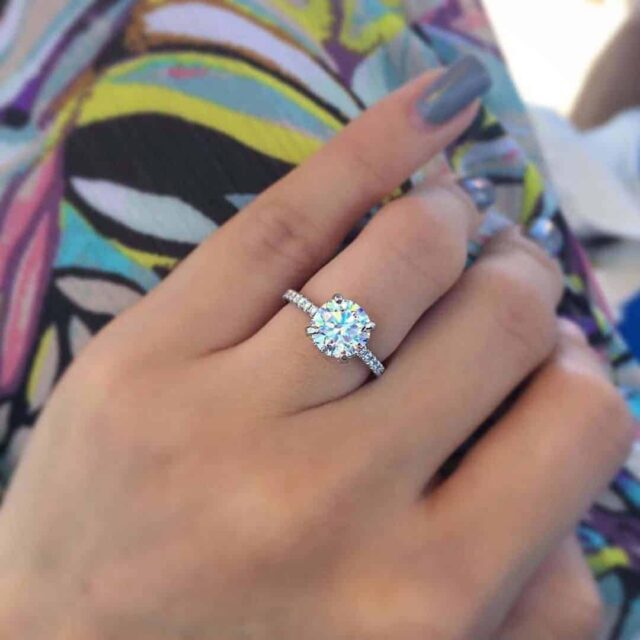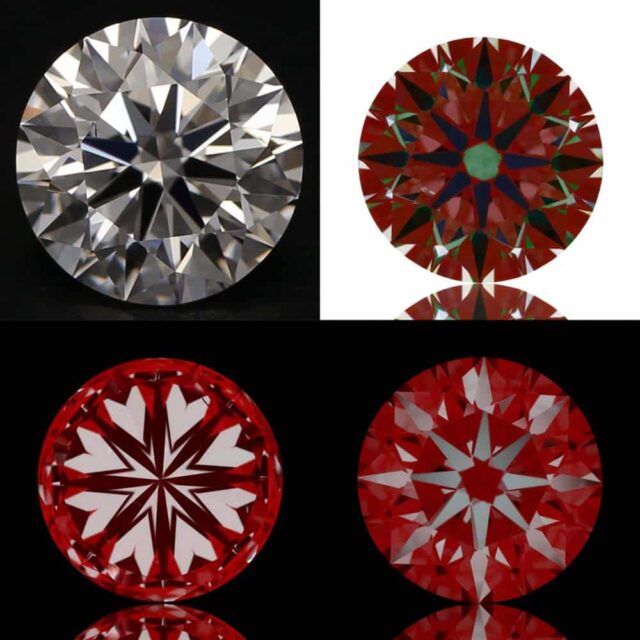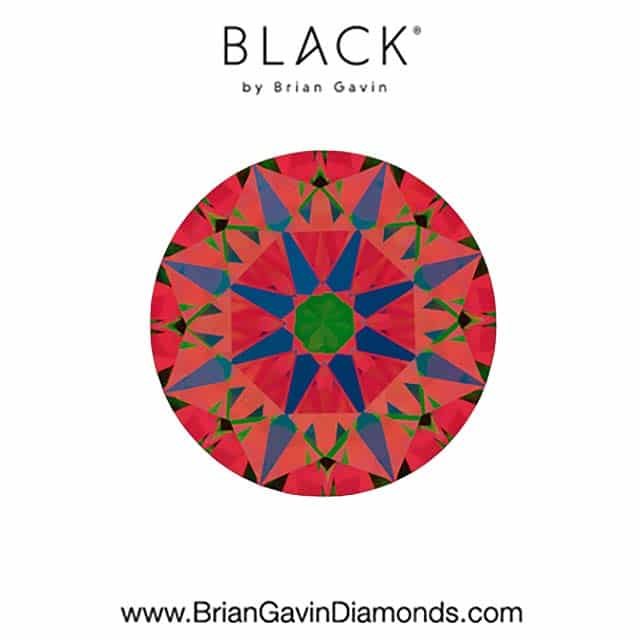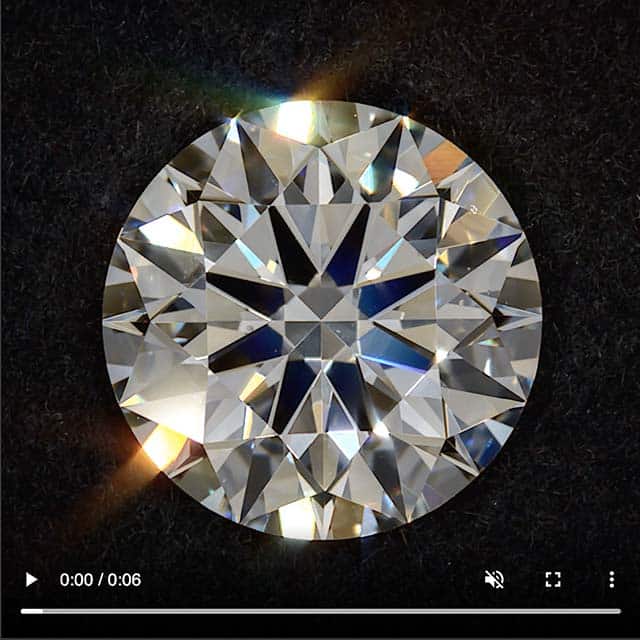Many people consider a one carat diamond ring the ideal size because it's significant enough to command attention from across the room, especially if cut well.
The following client inquiry is the basis for this tutorial: "My girlfriend wants a one-carat diamond. I wonder what tips and tricks you might have for buying the best-looking one-carat diamond for around $9-10K."
"As with most people, I imagine, I want the best deal on a 1-carat diamond, but I also want it to look incredible. I don't want to sacrifice light return or sparkle, and I want the diamond to look eye clean and white."
"From what I've read, this will be something like a VS-2 clarity, F-G color diamond. However, I've realized that my expectations are not in line with my budget."
"I've got champagne taste on a beer budget, as they say. Thus, I'm hoping you can guide me toward finding a good middle ground. Any help you can provide is greatly appreciated. I will use your links to buy the diamond, so you receive credit for helping me. Thank you."
Best One Carat Diamond Ring for $9-10K:
The challenge with looking for the best one carat diamond for 9-10K is our perception of what is best. It seems like everybody wants a one-carat diamond engagement ring.
Most people want a diamond that appears eye-clean and white in the face-up position. That means a minimum of VS2 clarity and F-G color if you have excellent vision.
Everybody also wants a diamond that practically sings when they look at it. That means that the diamond cut quality has to be superb.
Unfortunately, most standard ideal cut diamonds don't deliver the light performance you seek. However, sometimes we get lucky, so let's look around and see what we can find within the scope of my selection criteria.
Blue Nile One Carat Diamond Review, GIA #1289718328:
This 1.00 carat, F-color, VS-2 clarity, GIA Excellent cut round diamond from Blue Nile has a pavilion angle of 40.6 degrees offset by a crown angle of 35.0 degrees.
In that case, the diamond should exhibit a high volume of light return and a virtual balance of brilliance and dispersion. However, the proportions are only one piece of the puzzle.
The diamond details page provides a high-resolution video of the diamond. However, Blue Nile is not publishing the additional images the supplier provides:
The ASET Scope image in the upper right corner (above) looks decent. However, the light pink sections under the table facet indicate slight light leakage.
While people find light leakage alarming, it is essential to realize that this is not full-blown, or it would look more translucent.
Look closely, and you will see that the heart pattern exhibited by this diamond is not symmetrical. There are significant differences in the size and shape of the hearts.
You'll also see that the tips of the hearts are twisting, which indicates a difference in the length of the lower girdle facets. In that case, we know that this diamond has optical precision issues.
Ideal One Carat Diamond Ring Sparkle Factor:
If the diamond cutter which produced the one-carat diamond from Blue Nile above had spent more time fine-tuning the facet structure, they could have improved the light performance.
Look at how much better the ASET Scope image looks for this 1.043 carat, F-color, VS-2 clarity, Brian Gavin Black Hearts and Arrows Diamond.
Notice that you don't see any indications of light leakage under the table facet. Simultaneously, the light reflection pattern is more uniform and distributed more evenly.
That is what happens when a diamond cutter takes the time to align the facets of a diamond more precisely. It's also the difference between an ideal and super ideal cut diamond. Consequently, it's detectable to the naked eye without a reflector scope.
Super Ideal vs. Standard One Carat Diamond Ring:
Take a moment to see the difference between the Brian Gavin Black diamond on the left and the standard ideal cut diamond on the right. Then ask yourself, which of these ideal cut diamonds looks brighter and whiter?
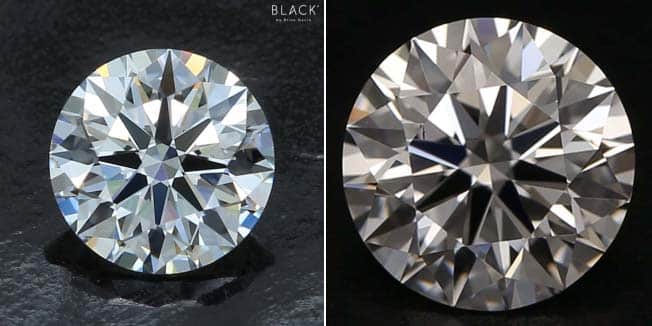
Black by Brian Gavin vs. GIA Excellent Cut.
Both diamonds have proportions in the middle of the spectrum for the AGS Ideal-0 cut proportions rating. The Brian Gavin Black diamond looks brighter because the higher degree of optical precision creates a higher volume of light return.
It also produces more virtual facets, which are the kaleidoscope-like internal reflections. As a result, the inverted triangular sections under the table facet appear to be whiter and brighter.
By the way, I want to be sure that we're both looking at the same thing. I am not referring to the difference in hue and saturation visible in these two photographs.
I do not doubt that the diamond on the right would look whiter if the photographer took a moment to adjust the camera settings correctly. In that case, focus on the difference in brightness visible between the arrows under the table facet.
Which One Carat Diamond Would I Pick for $9K?
Based on your preferences, if I had 9K to spend on a one-carat diamond, I would buy this 1.051 carat, H-color, VS-2 clarity, Brian Gavin Signature diamond.
First, the H-color appears bright and white for most people under normal circumstances. In that case, I don't see a benefit in spending more for a higher color grade.
Furthermore, if you set an H-color diamond in white metal prongs, it will likely face up more like G-color. That's because the color of the white metal is going to reflect throughout the diamond.
People often overlook the influence of blue fluorescence and metal color when buying a diamond. However, they can have a dramatic effect on appearance and price.
Now, let's talk about the cut quality of this diamond. The 40.8-degree pavilion angle will produce a high volume of light return. Simultaneously, the 34.3-degree crown angle will create a virtual balance of brilliance and dispersion.
As stated previously, diamond proportions are only one piece of the puzzle. The degree of optical precision also factors into the equation, but the ASET Scope image confirms this diamond looks outstanding.

